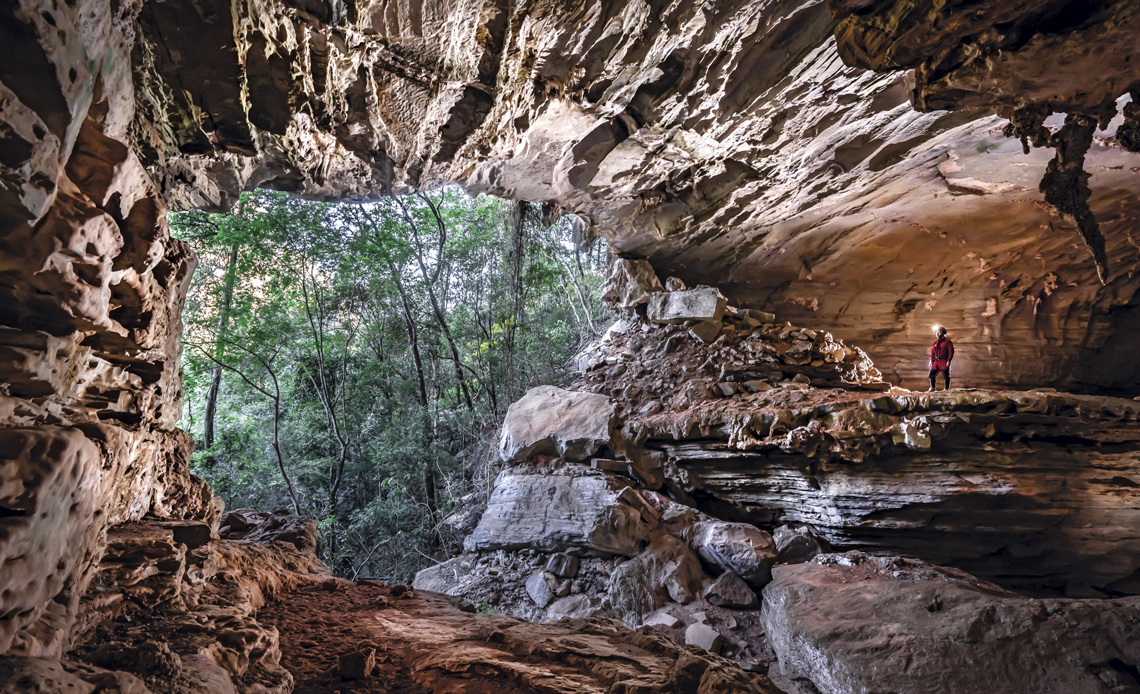The chemical composition of two stalagmites suggests that the north of Minas Gerais is currently facing its driest season in the last 720 years. The two long rock formations were found in Jaguar Cave, located in the valley of the Peruaçu River, a tributary of the São Francisco River. A group of geologists reconstructed the region’s historic climate by analyzing oxygen and carbon isotopes obtained from samples of the pair of stalagmites, which were formed by water rich in calcium and carbonate dripping from the cave’s ceiling.
Based on the proportion of different isotopes stored in the rocks, the researchers were able to infer the climate parameters from hundreds and even thousands of years ago, such as rainfall volume and evaporation (the latter of which is directly influenced by the increase in temperature). They then compared the oldest data with meteorological and climatological records from the surrounding areas and concluded that the area has been experiencing increasing aridity since the 1970s. Between 1979 and 2016, total rainfall declined by 7% per decade, equivalent to around 70 millimeters (mm), while evapotranspiration increased by 18% (125 mm) and the flow rate of local rivers fell by 20%. The region’s average temperature has risen by two degrees Celsius (ºC) in the last 250 years.
• Global warming leads to emergence of Brazil’s first arid zone and expansion of semiarid climate and dry areas
• Global warming accelerates the water cycle and increases evapotranspiration
“The rain can no longer keep up with the atmospheric demand for water due to the increase in evaporation associated with rising temperatures in recent decades,” explains geologist Nicolas Strikis of the Geosciences Institute at the University of São Paulo (IGC-USP), lead author of the article, published in the scientific journal Nature Communications at the end of February. Using computer models, the team also simulated what the climate might be like in the region if the volume of greenhouse gases in the atmosphere had not increased. They concluded that the water deficit can only be explained by taking into account the effects of global warming, a process mainly induced by human activity, such as the burning of fossil fuels and changes in land use (cutting down green areas to make room for other activities).
The study was only possible because Jaguar Cave, situated in the municipality of Januária, has very particular conditions and is located in an area with 110 years of meteorological records, a very long time by Brazilian standards. The cave is well ventilated and is located at the bottom of a valley, in a canyon 200 meters (m) deep. The cave entrance is a hole 50 m wide by 10 m high. The two stalagmites sampled in the study are in the transitional area that connects the interior of the cave with the climate of the outside world.
The relative humidity varies between 50% and 100% and temperatures range from 17 ºC in the winter to 25 ºC in the summer. “Studies carried out in a cave like this are rare,” says IGC-USP geologist Francisco Cruz, who is head of a FAPESP-funded project that is supporting the work. “Research is typically carried out in more closed caves, where the humidity and temperature are almost constant and the local atmosphere represents the internal environment only, not the outside.”
Another unusual element is that the cave’s surroundings are relatively undisturbed. Situated within the Peruaçu Caves National Park, a federal Conservation Unit, the cave is at the bottom of a valley, surrounded by mountains, where there is no agriculture or livestock farming. The local climate has therefore not been significantly affected by human activity.
This means that the chemical analyses of the rock samples from the cave entrance reflect the external climate of the region without major influence from local anthropogenic activities. “The natural conditions of the region alone do not explain our data,” notes meteorologist Marília Harumi Shimizu of Brazil’s National Institute for Space Research (INPE), coauthor of the paper. “The study shows that we must also take into account the global increase in greenhouse gas emissions when seeking to understand long-term droughts in eastern regions of South America.”
Project
Pire: Climate education and research in the Americas using the examples of tree rings and speleothems (Pire-Create) (nº 17/50085-3); Grant Mechanism Thematic Project; Principal Investigator Francisco William da Cruz Junior (USP); Investment R$7,247,472.50.
Scientific article
STRIKIS, N. M. et al. Modern anthropogenic drought in Central Brazil unprecedented during last 700 years. Nature Communications. Feb. 26, 2024.
